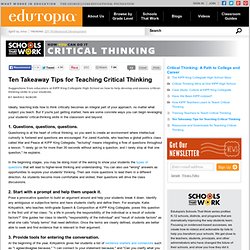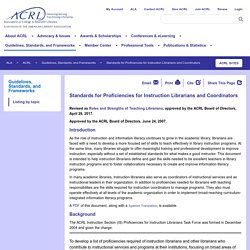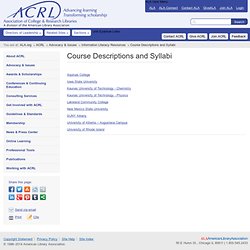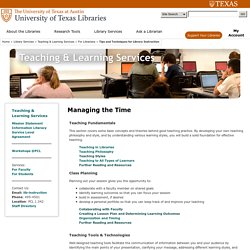

Assessment Toolkit. Teaching Critical Thinking. Suggestions from educators at KIPP King Collegiate High School on how to help develop and assess critical-thinking skills in your students.

Ideally, teaching kids how to think critically becomes an integral part of your approach, no matter what subject you teach. But if you're just getting started, here are some concrete ways you can begin leveraging your students' critical-thinking skills in the classroom and beyond. 1. Questions, questions, questions.
Questioning is at the heart of critical thinking, so you want to create an environment where intellectual curiosity is fostered and questions are encouraged. In the beginning stages, you may be doing most of the asking to show your students the types of questions that will lead to higher-level thinking and understanding. 2. Pose a provocative question to build an argument around and help your students break it down. 3. 4. 5. Lively discussions usually involve some degree of differing perspectives. 6. Resource Descriptions. ALA Info Lit Standards.
ACRL Proficiency Standards. Revised as Roles and Strengths of Teaching Librarians, approved by the ACRL Board of Directors, April 28, 2017.

Approved by the ACRL Board of Directors, June 24, 2007. Introduction As the role of instruction and information literacy continues to grow in the academic library, librarians are faced with a need to develop a more focused set of skills to teach effectively in library instruction programs. At the same time, many libraries struggle to offer meaningful training and professional development to improve instruction, especially without a set of established standards for what makes a good instructor. This document is intended to help instruction librarians define and gain the skills needed to be excellent teachers in library instruction programs and to foster collaborations necessary to create and improve information literacy programs. A PDF of this document, along with a Spanish Translation, is available.
Background Application of proficiencies in academic libraries. ACRL Sample Courses. Skip to main content ALA User Menu Search form Unit Eyebrow Links You are at: ALA.org » ACRL » Advocacy & Issues » Information Literacy Resources » Course Descriptions and Syllabi Share this page: Share on Facebook Share on Google+ Share on Pinterest Print Course Descriptions and Syllabi Aquinas College Iowa State University Kaunas University of Technology - Chemistry Kaunas University of Technology - Physics Lakeland Community College New Mexico State University SUNY Albany University of Alberta -- Augustana Campus University of Rhode Island © 1996–2014 American Library Association.

UT Library Instruction Methods. Teaching Fundamentals This section covers some basic concepts and theories behind good teaching practice.

By developing your own teaching philosophy and style, and by understanding various learning styles, you will build a solid foundation for effective teaching. Teaching in LibrariesTeaching PhilosophyTeaching StylesTeaching to All Types of LearnersFurther Reading and Resources Class Planning Planning out your session gives you the opportunity to: collaborate with a faculty member on shared goals identify learning outcomes so that you can focus your session build in assessment, if desired develop a personal portfolio so that you can keep track of and improve your teaching Collaborating with FacultyCreating a Lesson Plan and Determining Learning Outcomes Organization and TimingFurther Reading and Resources Teaching Tools & Technologies A combination of different teaching tools can supplement your instruction and make the session more meaningful for your students.
Active Learning. PRIMO Instructional Materials. Information Literacy.uk. S.O.S. for Information Literacy.